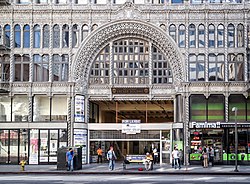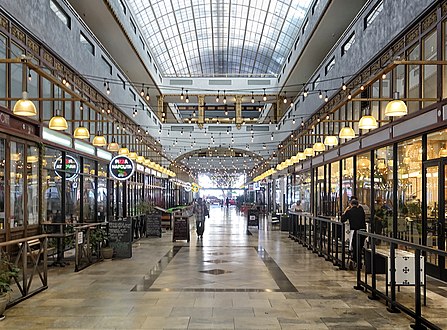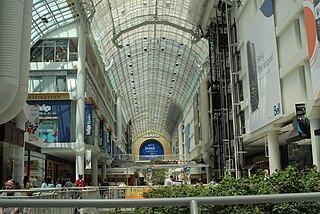
A shopping center, shopping centre, also called a shopping complex, shopping arcade, shopping plaza or galleria, is a group of shops built together, sometimes under one roof.

Downtown Los Angeles (DTLA) is the central business district of Los Angeles. It is part of the Central Los Angeles region and covers a 5.84 sq mi (15.1 km2) area. As of 2020, it contains over 500,000 jobs and has a population of roughly 85,000 residents, with an estimated daytime population of over 200,000 people prior to the COVID-19 pandemic. Despite a business exodus from downtown Los Angeles since the COVID-19 pandemic, the district is evolving as a cultural center.

Del Amo Fashion Center is a three-level regional shopping mall in Torrance, California, United States. It is currently managed and co-owned by Simon Property Group.
The Paseo is an outdoor mall in Pasadena, California, covering three city blocks with office space, shops, restaurants, a movie theater, and 400 loft-style condominiums above.
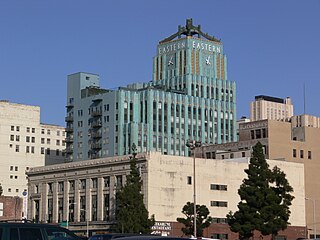
The Historic Core is a district within Downtown Los Angeles that includes the world's largest concentration of movie palaces, former large department stores, and office towers, all built chiefly between 1907 and 1931. Within it lie the Broadway Theater District and the Spring Street historic financial district, and in its west it overlaps with the Jewelry District and in its east with Skid Row.

Broadway, until 1890 Fort Street, is a thoroughfare in Los Angeles County, California, United States. The portion of Broadway from 3rd to 9th streets, in the Historic Core of Downtown Los Angeles, was the city's main commercial street from the 1910s until World War II, and is the location of the Broadway Theater and Commercial District, the first and largest historic theater district listed on the National Register of Historic Places (NRHP). With twelve movie palaces located along a six-block stretch of Broadway, it is the only large concentration of movie palaces left in the United States.
The Broadway was a mid-level department store chain headquartered in Los Angeles, California. Founded in 1896 by English-born Arthur Letts Sr., and named after what was once the city's main shopping street, the Broadway became a dominant retailer in Southern California and the Southwest. Its fortunes eventually declined, and Federated Department Stores bought the chain in 1995. In 1996, Broadway stores were either closed or converted into Macy's and Bloomingdales.

May Company California was an American chain of department stores operating in Southern California and Nevada, with headquarters at its flagship Downtown Los Angeles store until 1983 when it moved them to North Hollywood. It was a subsidiary of May Department Stores and merged with May's other Southern California subsidiary, J. W. Robinson's, in 1993 to form Robinsons-May.
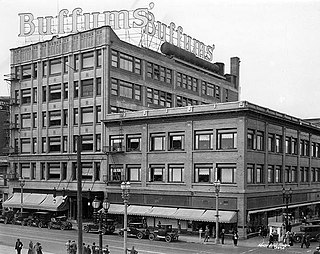
Buffums, originally written as Buffums' with an apostrophe, was a chain of upscale department stores, headquartered in Long Beach, California. The Buffums chain began in 1904, when two brothers from Illinois, Charles and Edwin Buffum, together with other partners, bought the Schilling Bros., the largest dry goods store in Long Beach, and renamed it The Mercantile Co. The store grew to a large downtown department store, and starting in the 1950s, grew slowly over the years to be a small regional chain of 16 speciality department stores across Southern California at the time of its closure in 1990.

FourFortyFour South Flower, formerly Citigroup Center, is a 627 ft (191 m) 48-story skyscraper at 444 South Flower Street in the Bunker Hill area of downtown Los Angeles, California. At the time of its completion, in 1981, the tower was the fifth-tallest in the city.
KRKD was an American radio station licensed to serve Dermott, Arkansas. It was assigned the KRKD call letters by the Federal Communications Commission on November 23, 1999. The station was most recently owned by Community Broadcast Group Inc., and the broadcast license held by M.R.S. Ventures, Inc. When KRKD went off the air permanently in early 2007, it broadcast a classic rock music format branded as "Rock 105.7".

The Broadway Theater District in the Historic Core of Downtown Los Angeles is the first and largest historic theater district listed on the National Register of Historic Places (NRHP). With twelve movie palaces located along a six-block stretch of Broadway, it is the only large concentration of movie palaces left in the United States. The same six-block stretch of Broadway, and an adjacent section of Seventh Street, was also the city's retail hub for the first half of the twentieth century, lined with large and small department stores and specialty stores.
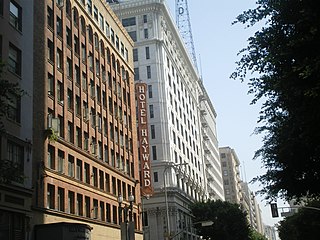
Spring Street in Los Angeles is one of the oldest streets in the city. Along Spring Street in Downtown Los Angeles, from just north of Fourth Street to just south of Seventh Street is the NRHP-listed Spring Street Financial District, nicknamed Wall Street of the West, lined with Beaux Arts buildings and currently experiencing gentrification. This section forms part of the Historic Core district of Downtown, together with portions of Hill, Broadway, Main and Los Angeles streets.

Cullen Center is a skyscraper complex in Downtown Houston, Texas, United States. The complex is now managed by Brookfield Properties. Previously Trizec Properties owned all four office buildings. The complex includes the headquarters of the Houston Fire Department and KBR, and it formerly included the headquarters of Continental Airlines.
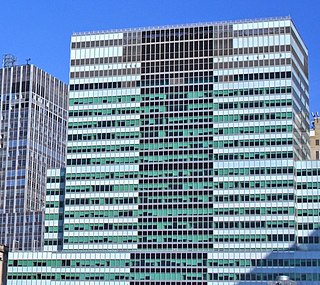
2 Broadway is an office building at the south end of Broadway, near Bowling Green Park, in the Financial District of Manhattan in New York City. The 32-story building, designed by Emery Roth & Sons and constructed from 1958 to 1959, contains offices for the Metropolitan Transportation Authority (MTA). 2 Broadway serves as the headquarters for some of the MTA's subsidiary agencies.
Spring Street School was the first public school in Los Angeles, California, built first at Second and Spring streets and then moved to a lot between Broadway and Spring Street midblock between Fifth and Sixth streets in the Downtown district.

The May Company Building on Broadway in Downtown Los Angeles, a.k.a. Hamburgers/May Company Department Store and the May Department Store Building, later known as the California Broadway Trade Center, was the flagship store of the May Company California department store chain. It is a contributing property to the NRHP-listed Broadway Theater and Commercial District.

Desmond's was a Los Angeles–based department store, during its existence second only to Harris & Frank as the oldest Los Angeles retail chain, founded in 1862 as a hat shop by Daniel Desmond near the Los Angeles Plaza. The chain as a whole went out of business in 1981 but Desmond's, Inc. continued as a company that went in to other chains to liquidate them. Desmond's stores in Northridge and West Covina were liquidated only in 1986 and survived in Palm Springs into the first years of the 21st century.

7th Street is a street in Los Angeles, California running from S. Norton Ave in Mid-Wilshire through Downtown Los Angeles. It goes all the way to the eastern city limits at Indiana Ave., and the border between Boyle Heights, Los Angeles and East Los Angeles.

Retail in Southern California dates back to its first dry goods store that Jonathan Temple opened in 1827 on Calle Principal, when Los Angeles was still a Mexican village. After the American conquest, as the pueblo grew into a small town surpassing 4,000 population in 1860, dry goods stores continued to open, including the forerunners of what would be local chains. Larger retailers moved progressively further south to the 1880s-1890s Central Business District, which was later razed to become the Civic Center. Starting in the mid-1890s, major stores moved ever southward, first onto Broadway around 3rd, then starting in 1905 to Broadway between 4th and 9th, then starting in 1915 westward onto West Seventh Street up to Figueroa. For half a century Broadway and Seventh streets together formed one of America's largest and busiest downtown shopping districts.
